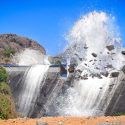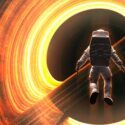Buckle up. We’re going to take the orbit of this rock and kick it into high gear. Behold the Moon breaking its planetary speed limit. How would this event flood cities? What would happen to the Earth’s crust? And why would the Moon go rogue?
The Moon orbits around our blue marble of a planet at the comfortable and reliable speed of 1 km/s (0.6 mi/s). And if that seems fast to you, hold on. You haven’t seen anything yet. So how could this happen? If the Moon kept getting closer to Earth, the gravitational pull from our planet would increase.
That would make the Moon’s orbit speed up tremendously. That’s the basis for Kepler’s third law. So if the Moon kept creeping toward Earth, it would orbit faster and faster. And if that happened, how would this event freeze the planet? Every 27 days, the Moon completes a trip around Earth.
Well, not anymore. Get ready to see this celestial body more often. And with the Moon’s increased visibility and speed, lunar eclipses would be a regular sight. But that lovely view in the sky wouldn’t make up for the hell on Earth below. If the Moon moved closer, the gravitational pull would rip into the Earth’s crust.
This increased force would create earthquakes and increase volcanic eruptions across the globe. And don’t think you could cool off by the ocean to escape the heat. Let me explain. The oceans ebb and flow thanks to the Moon’s orbit, the Earth’s gravity and the Sun.
So as the Moon inched closer, the ocean tides would become much larger. How large are we talking? They would be eight times higher than average. Coastal cities would flood, and some islands would become blanketed underwater for most of the day.
Almost 700 million people living in low-lying coastal areas would be in constant danger if they weren’t evacuated. But what would happen if the Moon started to move even faster? Well, remember Kepler’s third law?. The Moon would only orbit faster if it got closer. If it came within 18,470 km (11,470 mi), it would reach what’s called the Roche limit.
That’s the point where the Moon is so close to Earth that the tidal forces between us would get strong enough to tear this grey rock apart. Thankfully, this wouldn’t be able to happen. Because as its speed increased, our Moon would be launched into the cosmos.
Yeah, that’s because once our natural satellite reached 1.4 km/s (0.87 mi/s), it would have enough momentum to escape Earth’s gravity. As it fades from sight, you might feel relieved at first. After all, the Earth’s rotation would slow down without the Moon, so the days would become longer.
And finally, you would see an end to the constant earthquakes and devastating floods. But in reality, this is where the real nightmare begins. The tides would become smaller and weaker without the Moon. Any coastal ecosystems that weren’t already destroyed by massive flooding would now be completely upended.
Without churning tides, animals that depend on food sources normally floating in the ocean wouldn’t get the nutrients they need to live. And without the Moon’s light, nocturnal predators would have difficulty completing a successful hunt. This could create a mass extinction event of creatures on land and at sea.
And while life on Earth would be flipped on its ear, so would the planet. Earth has a tilt of about 23.5 degrees. This angle of its orbit makes the seasons possible. But it’s the Moon’s gravity that stabilizes this tilt from going any further. So without it, the seasons could stop. Weather patterns might hold in place until the end of time.
But if the tilt increased, it could cause extreme weather conditions. And once again, the Earth could be plunged into an ice age. Yeah, a faster lunar orbit could fast-track all life on Earth to extinction. Okay, so instead of losing the moon, what if we crowded the sky with the moons of Jupiter?
Sources
- “Relation Between Escape Velocity And Orbital Velocity”. 2022. byjus.com.
- “Moon Fact Sheet”. 2022. nssdc.gsfc.nasa.gov.
- “Kepler’s Laws Of Orbital Motion | How Things Fly”. 2022. howthingsfly.si.edu.
- “Planetary Fact Sheet”. 2022. nssdc.gsfc.nasa.gov.
- “What Would Happen To Earth’s Orbit If The Sun Vanished? | BBC Science Focus Magazine”. Dr Alastair Gunn. 2022. sciencefocus.com.



























